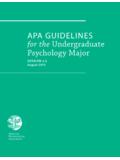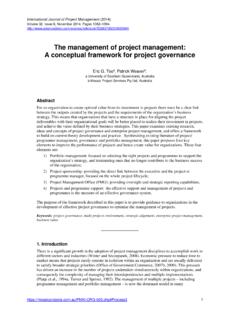Transcription of Educational Interventions for Children Affected by Lead
1 Educational Interventions for Children Affected by Lead National Center for Environmental Health Division of Emergency and Environmental Health Services April 2015 This paper was developed by an expert panel that included CDC and non-CDC authors. The information contained in this paper has been prepared and is presented for informational and Educational purposes only. The information in this paper is not intended to be legal advice and should not be construed as legal advice or a legal determination about eligibility for any program or benefit. ii This document is dedicated to the memory of Dr. Vivian A. Cross of Simsbury, Connecticut, who passed away May 3, 2014. She was an extraordinary educator, community activist, and champion for Children with special needs.
2 Dr. Cross implemented major Educational and legislative informational forums, media conferences, and professional development training initiatives including the 2012 Legislative Informational Forum titled A Call To Action to Eliminate a Preventable Contributor to the Achievement Gap Childhood Lead Poisoning. She was a guiding light on the expert panel and her thoughtful contributions will be deeply missed as the work moves forward. Suggested citation: Educational Services for Children Affected by Lead Expert Panel. Educational Interventions for Children Affected by lead. Atlanta: Department of Health and Human Services; 2015. iii Members of Expert Panel Sher Lynn Gardner, MD, FAAP Assistant Professor of Pediatrics Emory University Atlanta, GA Expert Panel Chair Chair, Educational Interventions for Lead-Exposed Children Work Group (2008-2013) Mary Jean Brown, ScD, RN Chief, Healthy Homes and Lead Poisoning Prevention Program National Center for Environmental Health Centers for Disease Control and Prevention Atlanta, GA Designated Federal Official, Advisory Committee on Childhood Lead Poisoning Prevention (2003-2012) Designated Federal Official, Educational Interventions for Lead-Exposed Children Work Group (2013) Cassandra Archie Founder Advocates for Educational Equity and Excellence New York, NY Helen J.
3 Binns, MD, MPH Professor of Pediatrics and Preventive Medicine Northwestern University Feinberg School of Medicine and Ann & Robert H. Lurie Children s Hospital of Chicago Chicago, IL Member, Advisory Committee on Childhood Lead Poisoning Prevention (2003-2012) Vivian Cross, PhD [deceased] executive Director Foundation for Educational Advancement, Inc. Hartford, CT Kim N. Dietrich, PhD, MA Professor and Director Division of Epidemiology and Biostatistics Associate Director, Molecular Epidemiology Training Program Department of Environmental Health University of Cincinnati Cincinnati, OH Member, Advisory Committee on Childhood Lead Poisoning Prevention (2003-2012) Sue Gunderson executive Director CLEARC orps USA Valarie Johnson Founder and executive Director Education Consultant and Advocate Urban Parent to Parent Rochester, NY Linda Kite executive Director Healthy Homes Collaborative Los Angeles, CA Jane Malone Director of Policy National Center for Healthy Housing Washington, DC Liaison to Advisory Committee on Childhood Lead Poisoning Prevention (2006-2012)
4 Educational Interventions for Children Affected by Lead iv Pat McLaine, DrPH, MPH, RN Assistant Professor University of Maryland School of Nursing Department of Family and Community Health Baltimore, MD Reghan O. Walsh Public Health Educator Wisconsin Childhood Lead Poisoning Prevention Program Prevention State Department of Health Services Division of Public Health Milwaukee, WI Dana Williams Parent Representative Advisory Committee on Childhood Lead Poisoning Prevention (2008-2012) Atlanta, GA Pongsuda Rattanamasmongkol, EdS, RN Technical Reviewer/Consultant Doctoral Candidate Special Education Program George Washington University Washington, DC Educational Interventions for Children Affected by Lead v Table of Contents Preface .. vi executive Summary.
5 Vii Abbreviations .. x Chapter 1: Introduction .. 1 Chapter 2: Neurodevelopmental Consequences of Lead Exposure .. 3 Chapter 3: Who Is At Risk? Vulnerable Populations and Risk Factors .. 9 Chapter 4: Consequences of Lead on Learning and Educational Attainment .. 13 Chapter 5: Effectiveness of Early Childhood Education Programs in Reducing Developmental Risks .. 16 Chapter 6: Applicable Federal Programs and Policies .. 20 Chapter 7: Services Available for Lead-Exposed Children .. 39 Appendix 1: Resources for Obtaining Services and Improving Systems .. 45 Appendix 2: State Summary of Early Intervention Eligibility, 2013 .. 48 Appendix 3: Federal Definitions of Child with a Disability .. 50 References .. 55 Educational Interventions for Children Affected by Lead vi Preface Lead is a neurotoxicant with well documented and lasting adverse health effects.
6 Primary prevention strategies that control or eliminate lead sources before Children are exposed remain the pre-eminent public health approach to the problem of lead poisoning and are the only effective way to prevent the neurodevelopmental and behavioral abnormalities associated with lead exposure. Unfortunately, though, hundreds of thousands of Children already have experienced blood lead levels known to impair academic performance and affect life success. Thus, tertiary prevention (that is, strategies that restore individuals to an optimal level of functioning after damage is done) is also needed. Recognizing the need to ensure that Children Affected by lead receive timely and appropriate Educational Interventions , the Centers for Disease Control and Prevention and the Advisory Committee on Childhood Lead Poisoning Prevention convened a work group of recognized experts to review the existing scientific evidence for adverse effects of blood lead levels on academic performance and describe actionable steps that clinical and public health practitioners, parents, and educators can take to ensure that the Children receive such services.
7 Educational Interventions for Children Affected by Lead outlines available scientific data describing the effects of lead, summarizes in plain language the Individuals with Disability Education Act (IDEA) parts B and C, and provides information on how these provisions relate to Children Affected by lead. The document also describes major gaps in our scientific understanding of the efficacy of Educational Interventions for reversing academic problems in Children Affected by lead. The importance of addressing these gaps could be considered as institutions design their research portfolios. I wish to thank the members of the Advisory Committee on Childhood Lead Poisoning Prevention, members of the Educational Services for Children Affected by Lead Expert Panel, and consultants who developed this document and acknowledge their contribution to the health of the Nation s Children .
8 This document significantly advances our efforts to improve the lives of Children negatively Affected by lead exposure by providing information on the services designed to improve academic performance to the stakeholders and partners that are most in need it. Patrick N. Breysse, PhD, CIH Director, National Center for Environmental Health and Agency for Toxic Substances and Disease Registry Centers for Disease Control and Prevention Educational Interventions for Children Affected by Lead vii executive Summary Lead is a developmental neurotoxicant, and high blood lead levels (HBLLs) in young Children can impair intellectual functioning and cause behavioral problems that last a lifetime. Primary prevention of HBLLs remains a national priority and is the only effective way to prevent the neurodevelopmental and behavioral abnormalities associated with lead exposure.
9 Unfortunately, hundreds of thousands of Children already have experienced blood lead levels known to impair academic performance. To ensure that such Children are provided with the services that may help improve academic and other outcomes, in 2008 the CDC Advisory Committee on Childhood Lead Poisoning Prevention convened a work group charged with describing specific action steps parents, clinicians, educators, lead poisoning prevention programs, and others who work with Children may be able to take to ensure that Children Affected by lead receive timely and appropriate Educational Interventions . This report was drafted by these experts, who were chosen for their diverse perspectives and technical expertise and reflects their insight, knowledge, and practical expertise.
10 The body of evidence cited in this document demonstrates the effects that low-level lead exposure has on the brain s learning systems: overall intellectual ability, speech and language, hearing, visual-spatial skills , attention, executive functions, social behavior, and fine and gross motor skills . It details the significant negative consequences of lead on learning and Educational attainment found in study after study (see Table 1) and the costs associated with those consequences. It describes the challenges Children face as they advance through the school system and how lead interferes with development and learning. There are no studies that specifically examine the impact of early childhood Educational Interventions on cognitive or behavioral outcomes for Children who have been exposed to lead.


















